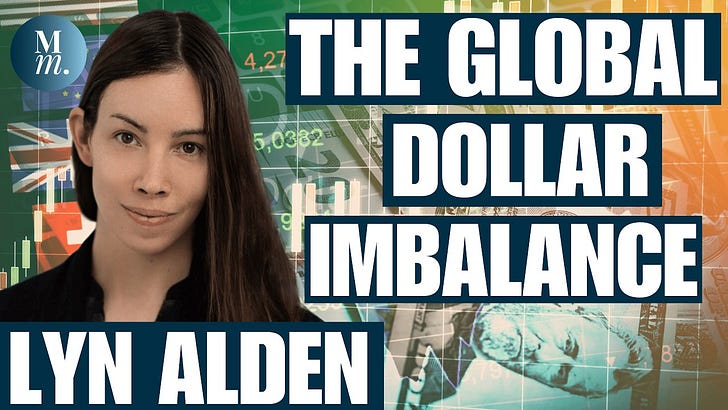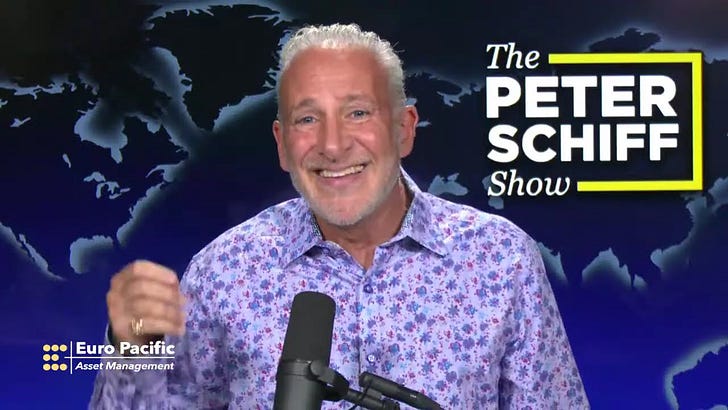Lyn Adlen was interviewed by Monetary Matters and it is jam packed with insight. I myself had to leverage NotebookLM to unpack it all after the 1 hour interview which I have included here:
Hope you enjoy and get value from both the source interview and the AI generated summary with debrief and study guide. One thing is for sure, it is getting more complicated than simply “buy the dips and yolo” as a strategy.
Debriefing
Date: May 9, 2024 Source: Excerpts from "How Tariffs Will Transform U.S. Dollar Capital Flows Worldwide | Lyn Alden"
Executive Summary:
This briefing document analyzes the potential consequences of the Trump administration's tariffs on global capital flows, the US dollar's reserve currency status, and the broader economic landscape, drawing insights from an interview with Lyn Alden. Alden argues that while the administration's goal of addressing trade imbalances is understandable, the use of tariffs as a primary tool carries significant risks, particularly in the short term. These risks include immediate economic disruption, potential capital outflows from the US, and a challenge to the dollar's global dominance. The interview highlights the intricate relationship between trade deficits (the mechanism for dollar outflow) and the dollar's reserve currency status, suggesting that tariffs alone cannot solve the underlying structural issues. Alden also discusses the potential for inflationary or stagflationary pressures, the impact on global markets, and the long-term implications for the US within the context of the long-term debt cycle and a potentially shifting global monetary order.
Main Themes and Important Ideas/Facts:
1. The Intertwined Nature of Trade Deficits and the Dollar's Reserve Currency Status:
Alden emphasizes that the US structural trade deficit is a mechanism for dollars to flow out into the world, fulfilling the global demand for the reserve currency.
"the trade deficit is the mechanism for how the dollars get out into the world to serve as the global reserve currency"
The global need for dollars (for reserves, cross-border funding, trade denomination) creates an "insatiable demand" and an "extra structural bid" for the currency, making the dollar somewhat artificially strong.
This strong dollar makes it less competitive for the US to manufacture goods, even compared to other developed nations.
"especially for lower margin things it's it's generally less economical to produce them in the US even compared to other developed countries"
Alden posits that even if other countries lowered their tariffs, the US would still face headwinds due to the dollar's reserve status, making US manufacturing less competitive.
2. Immediate Consequences of Tariffs and Potential Market Disruptions:
Tariffs have an immediate impact, unlike structural changes which take years.
"the consequences of the tariffs hit right away Whereas some of the things that you're trying to structurally change can take years or in some cases decades"
Rapidly restricting the outflow of dollars through high tariffs can "seize up the system" and have negative consequences both domestically and internationally.
Entities holding dollar liabilities may be forced to sell US assets to obtain dollars if their access to dollars through trade is reduced, leading to potential capital outflows.
"instead of a shift from stocks to bonds it's an outright capital outflow something you typically see in emerging markets"
This could lead to "illiquid downward moves in US assets" and potentially challenge the traditional safe-haven status of US bonds.
3. The Challenge of Rebuilding US Manufacturing:
Revitalizing US manufacturing requires significant investment in facilities, automation, skilled labor, and energy infrastructure – a "multi-year thing."
Simply imposing tariffs does not automatically create the necessary domestic capacity at scale.
"You have to build more manufacturing facilities. You have to have tons of automation or skilled workers to to run them you generally have to have more energy infrastructure."
4. Potential for Inflation or Stagflation:
Sustained higher inflation generally requires money supply growth.
Tariffs on goods, particularly from China, are likely to be inflationary in the short term.
However, reduced economic activity due to tariffs could lead to disinflation in other areas and potentially weaker asset prices.
A stagflationary scenario could arise if tariffs disrupt supply chains while large fiscal deficits are monetized by the Federal Reserve.
"if they go back to QEA increasing their balance sheet to support some of those fiscal deficits and the and the bond market in particular if that were to happen then that's how you get a stagflationary scenario in my view"
5. Impact on US-China Trade Relations and Global Order:
While the US trade deficit with China is significant, it represents a smaller portion of China's total global exports.
China's growing strength in other export sectors (e.g., automobiles) provides a potential buffer.
The US strategy of building a coalition against China suggests an awareness of the limitations of unilateral tariffs.
Alden believes the US likely seeks a "Mara Lago accord" involving some de-escalation, a stronger Chinese yuan, and more balanced trade terms.
The administration's goal might be to "at least start the process of rebalancing global trade," recognizing it as a long-term endeavor.
6. The Long-Term Debt Cycle and Fiscal Constraints:
The US is in a phase where private debt has peaked and sovereign debt is increasing due to fiscal deficits, demographics, and rising interest expenses.
Austerity measures or significant tax increases (like tariffs) could have near-term deficit reduction effects but may lead to a "hangover" due to impacts on markets and tax receipts.
Alden views it as "very low probability that they're going to meaningfully reduce the fiscal deficit" in the near term due to structural factors and political promises.
7. Financial Markets as a Vulnerability:
While some argue the deficit country has an advantage in a trade war, China's substantial financial assets (accumulated from trade surpluses) provide it with significant leverage.
China could potentially use its holdings of US Treasuries as a tool in the trade conflict, impacting US financial markets.
"our financial markets are one of our Achilles heels that especially really big creditor nations can go after"
The administration's desire for lower long-term interest rates could be challenged by these financial dynamics.
8. Global Implications Beyond the US and China:
A slowdown in global growth due to tariffs would impact most countries, even those not directly targeted.
Countries with lower starting valuations in their stock markets may be more insulated from significant capital flight.
Alden emphasizes the importance of valuation as a defensive tool in uncertain times.
9. Elasticities and Business Responses to Tariffs:
Initially, companies are likely to adopt a "wait and see" approach due to uncertainty about the longevity of tariffs.
If tariffs are perceived as sustained, businesses will likely explore options such as shifting supply chains (potentially to the US or other countries), which is a costly and time-consuming process.
Some companies may face squeezed margins, while others might attempt to pass on costs to consumers.
10. Fiscal Stimulus vs. Tariff Impact:
The current tariffs represent a "multi-hundred billion dollar tax increase."
The potential positive impact of proposed tax cuts and deregulation needs to be considered in relation to the scale of this tariff increase.
As of the interview, it appears difficult to fully offset the tightening effect of the tariffs with other fiscal measures.
11. Federal Reserve in a Fiscal Dominant Environment:
Alden argues that the current environment is more "fiscal dominant," meaning fiscal policy decisions (including tariffs and deficits) have a greater impact than monetary policy.
Stagflation would be the worst-case scenario for the Fed, creating conflicting pressures on interest rates.
The Fed may be forced to intervene to provide liquidity in the Treasury market, even if inflation remains high, potentially compromising its independence.
Alden anticipates a move towards ending quantitative tightening and a gradual increase in the Fed's balance sheet in the future.
12. Potential for a Dramatic Dollar Dumping:
While the demand for dollars remains largely inflexible due to significant dollar-denominated debt, Alden sees a "low but elevated probability" of a more dramatic dollar sell-off due to the current policy environment.
The dollar's history of major cycles suggests further weakening is possible.
However, a complete and sudden collapse of the dollar's reserve status is considered unlikely due to the strength of the network effect and the existing dollar-denominated liabilities.
13. Preference for Foreign Markets:
Alden maintains a preference for foreign markets over US stocks due to the risk of shifting capital flows, starting valuations, and the current US policy shift.
While short-term counter-moves are possible, the longer-term outlook favors diversification into international equities to mitigate the risk of a prolonged period of underperformance in the US market.
Key Quotes:
"the trade deficit is the mechanism for how the dollars get out into the world to serve as the global reserve currency"
"especially for lower margin things it's it's generally less economical to produce them in the US even compared to other developed countries"
"the consequences of the tariffs hit right away Whereas some of the things that you're trying to structurally change can take years or in some cases decades"
"instead of a shift from stocks to bonds it's an outright capital outflow something you typically see in emerging markets"
"our financial markets are one of our Achilles heels that especially really big creditor nations can go after"
"if they go back to QEA increasing their balance sheet to support some of those fiscal deficits and the and the bond market in particular if that were to happen then that's how you get a stagflationary scenario in my view"
Conclusion:
Lyn Alden's analysis suggests that the Trump administration's aggressive use of tariffs to address trade imbalances poses significant risks to global capital flows and the US economy. While the long-term goal of rebalancing trade is understandable, the immediate consequences of tariffs could include market volatility, capital outflows, and inflationary pressures. Furthermore, the dollar's role as the global reserve currency is intrinsically linked to the trade deficit, and abruptly halting dollar outflows could have unintended and negative ramifications. Alden advocates for a more nuanced approach that considers the structural underpinnings of trade imbalances and the potential for a multipolar global monetary order. The current environment necessitates caution for investors, with a focus on diversification and an awareness of the evolving global economic and financial landscape.
Study Guide
Study Guide: Tariffs and Global Capital Flows
Quiz
According to Lyn Alden, what is the mechanism by which the US dollar flows out into the world to serve as the global reserve currency? What happens if the US attempts to quickly stop this flow?
Explain the structural advantage the US dollar has as the global reserve currency. How does this relate to the US trade deficit, according to Alden?
Alden suggests that the Trump administration likely desires a weaker dollar. How might they express this goal, and what competing views exist within the administration regarding the dollar's strength?
Describe the intrinsic link between trade imbalances and capital account balances. What potential financial implications could arise if the US trade deficit narrows significantly due to tariffs?
What is Alden's perspective on the effectiveness of tariffs in addressing the underlying issue of the US trade deficit? What other factors contribute to this deficit?
What are some of the immediate consequences of tariffs, and why might it take years or even decades to achieve the structural changes that tariffs aim to bring about in the US economy?
Explain Alden's view of the long-term debt cycle and where the US currently stands within it. How do tariffs potentially complicate efforts to address the fiscal deficit?
What is Alden's assessment of the argument that the deficit country (like the US in its trade with China) has an inherent advantage in a trade war? What financial vulnerability does the US possess?
According to Alden, are tariffs likely to be more inflationary or stagflationary? What conditions could contribute to a stagflationary scenario?
What are the potential outcomes for companies like Apple, which have significant production in China, if high tariffs on Chinese imports are sustained? What are the most likely scenarios Alden envisions?
Answer Key
The trade deficit is the mechanism for how dollars get out into the world to serve as the global reserve currency. If the US tries to quickly stop this flow, the system could seize up, leading to negative consequences both domestically and internationally.
As the global reserve currency, there is an extra layer of demand for the dollar because countries need it for reserve assets, cross-border funding, and international contracts, even beyond direct trade with the US. This insatiable demand makes the dollar somewhat artificially strong, making it less economical to produce lower-margin goods in the US and contributing to the structural trade deficit.
The Trump administration would likely phrase their desire for a weaker dollar as wanting other currencies to not be "unfairly priced." However, some within the administration also express interest in attracting more foreign investment in US assets, which could conflict with a weaker dollar policy.
Trade imbalances and capital account balances are intrinsically linked because the dollars that flow out due to imports often return as investments in US assets. If the trade deficit narrows due to tariffs, there might be less foreign capital flowing back into US markets, potentially leading to weaker asset price performance.
Alden believes that while tariffs are a part of the equation, they don't tackle the underlying issue of the US trade deficit, which is linked to the dollar's role as the global reserve currency. Other factors like higher US healthcare costs and the erosion of certain manufacturing skills in the US also contribute.
Immediate consequences of tariffs include increased costs for businesses and potential disruptions to supply chains. Structurally changing the US economy, such as rebuilding manufacturing facilities, developing necessary know-how, and reorganizing supply chains, is a complex and time-consuming process that can take many years.
Alden views the US as being in a phase of the long-term debt cycle where private debt has peaked and shifted to the sovereign level, resulting in large fiscal deficits. Tariffs, being a form of tax increase or austerity measure, could have near-term effects on reducing the deficit but might lead to a subsequent economic slowdown that weakens tax receipts.
While the US, as a deficit country, might seem to have economic leverage, Alden points out that China, as a creditor nation with substantial financial assets, has the capacity to impact US financial markets. The US's structural fiscal deficits also create an economic vulnerability.
Alden believes tariffs could be inflationary for goods now associated with China but disinflationary for other products due to a potential economic slowdown. A stagflationary scenario could arise if tariffs lead to supply chain disruptions combined with large monetized fiscal deficits (the Fed increasing its balance sheet to support government spending).
If high tariffs on Chinese imports persist, Alden anticipates several potential outcomes for companies like Apple: increased prices for consumers, significantly reduced profit margins for Apple, decreased demand due to higher prices, or Apple attempting to reroute production through other countries. The most positive scenario for markets might be a de-escalation of tariffs or successful routing of production.
Essay Format Questions
Analyze the interconnectedness of the US dollar's role as the global reserve currency, the persistent US trade deficit, and the potential impact of tariffs on global capital flows. Discuss the inherent challenges in attempting to resolve the trade deficit without affecting the dollar's global standing.
Evaluate Lyn Alden's perspective on the Trump administration's use of tariffs as a tool to rebalance global trade. Consider the intended goals, the potential economic consequences (both immediate and long-term), and the structural factors that might limit the effectiveness of this approach.
Discuss the potential impact of sustained high tariffs on the long-term debt cycle in the United States. Analyze how these tariffs might interact with existing fiscal pressures and the Federal Reserve's policy decisions in the coming years.
Compare and contrast the potential advantages and disadvantages for both the United States and China in the current trade environment, considering both economic and financial levers. Analyze which country, in Lyn Alden's view, holds a more significant long-term strategic advantage.
Based on Lyn Alden's analysis, outline potential investment strategies that individuals and institutions might consider in light of the current global trade and capital flow dynamics, particularly considering the uncertainty surrounding tariffs and their broader economic implications.
Glossary of Key Terms
Tariff: A tax imposed by a government on goods and services imported from other countries.
Trade Deficit: An economic condition in which a country's imports exceed its exports.
Global Reserve Currency: A currency that is widely held by central banks and financial institutions around the world for international transactions, investments, and as a store of value.
Capital Flows: The movement of money for the purpose of investment, trade, or business production.
Capital Account Balance: The difference between a nation's savings and its investment. It reflects the net change in ownership of national assets.
Monetary Policy: Actions undertaken by a central bank to manipulate the money supply and credit conditions to stimulate or restrain economic activity.
Fiscal Policy: The use of government spending and taxation to influence the economy.
Inflationary: Relating to or causing an increase in the general price level of goods and services in an economy over a period of time.
Stagflationary: An economic condition characterized by slow economic growth and relatively high unemployment (stagnation) while also having rising prices (inflation).
Long-Term Debt Cycle: A macroeconomic theory describing how long-term accumulations of debt in the private sector eventually lead to crises, followed by a shift of debt to the sovereign level and subsequent challenges in managing that public debt.
Austerity Measures: Government policies aimed at reducing budget deficits, often through spending cuts or tax increases.
Financialization: The increasing importance of financial markets, financial institutions, and financial elites in the operation of the economy and its governing institutions.
Monetized Fiscal Deficits: A situation where a central bank increases the money supply to finance government debt.
Liquidity: The availability of liquid assets (assets that can be easily converted into cash) in a market or financial system.
Quantitative Easing (QE): A monetary policy tool where a central bank injects liquidity into money markets by purchasing assets without the goal of lowering the policy interest rate.
Quantitative Tightening (QT): A monetary policy tool used to decrease liquidity in money markets by allowing assets on a central bank's balance sheet to mature without reinvesting them or by actively selling them.
Triffin Dilemma: The conflict of economic interests that arises between domestic and international objectives when a country's currency is used as a global reserve currency. To supply enough currency for global needs can lead to trade deficits and potential loss of confidence in the currency's value.
Multipolar Currency World: A global financial system in which multiple currencies are widely used for international transactions and held as reserve assets, rather than a single dominant currency.
Fiscal Dominance: An economic environment where fiscal policy decisions significantly outweigh the influence of monetary policy.
Network Effect: The phenomenon whereby the value of a product or service increases as more people use it.
NotebookLM can be inaccurate; please double check its responses.










Share this post